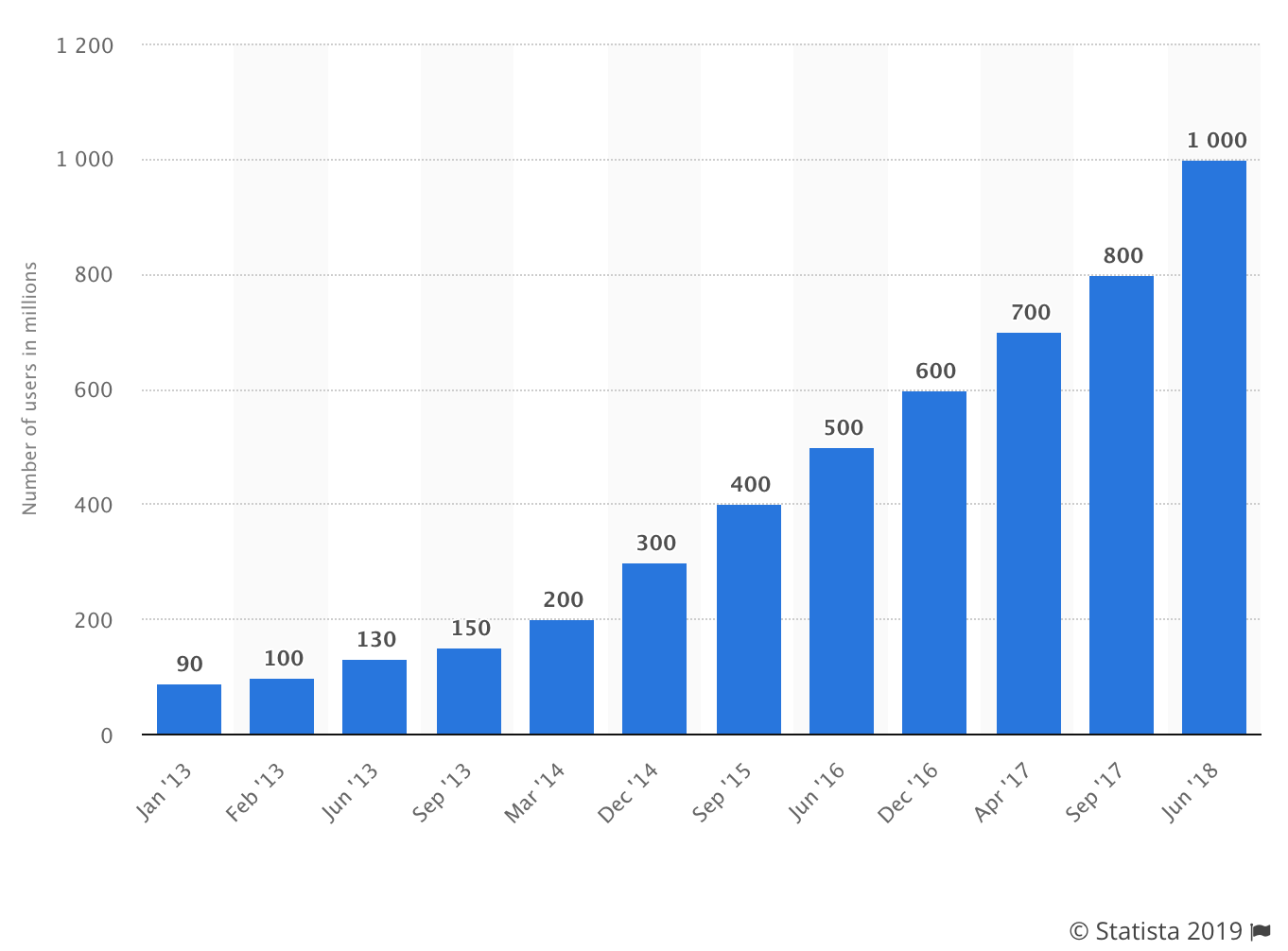Instagram is one of the fastest growing social media platforms available to modern marketers. The overall number of its active users has grown from 400 million users in 2015 to almost 1 billion in 2019.

The most relevant fact for marketing professionals is the unprecedented customer conversion potential provided by this social media platform.
According to the recent study, almost 75% of Instagram users made beauty, style or fashion-related purchases after seeing related Instagram posts. Moreover, high conversion figures exceeding 54% were found in all age categories including baby boomers and Generation X customers. This suggests that marketers need to be aware of the most effective instruments provided by this platform.
Below are the 5 Instagram trends in 2020 that may be valuable for marketing your products, blog, and services through social media.
5 Instagram Trends To Watch Out For
Trend 1: A Shift to User-Generated Content
Instagram has significantly changed its approach to user-generated content in early 2020. While previously marketing engagement was simply defined as the number of views, the addition of polls and stickers in Instagram stories meant that the brand followers became a marketing channel in their own right.
More than 400 million people watched Instagram stories every day in 2020, illustrating this. Branded stickers that could be used in reactions to stories have slowly become one of the most crucial visuals in Instagram marketing trends, raising both brand knowledge and awareness. The visual identity of brands was no longer limited to their posts and stories.
Brand impressions also extended to how the followers used stickers and tags to raise brand awareness among other users. Previously, however, brands could receive updates if their stories or content were screenshotted by users, which provided for a very good tracking mechanism to study followers. Unfortunately, this feature was canceled and now marketers have to rely on specialized third-party instruments such as Later.

Instagram is currently working on auto-publishing features for business profiles. This way, brands can schedule future posts for the identified optimal periods and publish them through your profile.
Trend 2: Changing the Authenticity of Brand Influencers
Although spending on brand influencers is expected to reach $10 billion by 2020, more and more users have grown frustrated with sponsored content and inauthentic influencers. The believability of influencers has become a vital factor influencing whether the brand followers would react to promotions.
For instance, @JennaKutcher has managed to acquire more than 500,000 in a year without relying on explicit advertising. Her success was attributed to spreading an authentic body positivity image (personal branding) and highlighting how her daily life was affected by her promoted brands.
Bought influencers have quickly lost value; instead, authentic influencers have become the main stakeholder for Instagram marketers aiming to grow their brand following and increase engagement.
Trend 3: Relying on Micro-Influencers
Instagram has been slowly transforming into a valuable platform for e-commerce with there existing almost 73% of Instagram users who have purchased the products advertised on the network at least once. Nonetheless, the issue was in reaching the accounts who did not visit Instagram frequently and had a small circle of followers. Businesses have repeatedly contacted micro-influencers to change this with spectacular results.
Micro-influencers are personal accounts on Instagram with less than 1,000 followers; their focus is on the personal lives of the account holders rather than advertising. Because of this, the promotional messages distributed by such users are perceived to be more believable and relatable than the campaigns led by popular accounts.
Another benefit of using micro-influencers is that their small number of followers frequently includes immediate friends and family members. This means that your brand might be sponsored not only on Instagram but also within these hard-to-reach communities.
Trend 4: Augmented Reality Filters
Instagram has recently added face filters with augmented reality capabilities following the trend set by Snapchat. At first glance, this option is merely a way to liven up selfie pictures by adding some special effects to people faces. However, these instruments are still in development at the moment and may contain a substantial potential for future marketers as the alternative to hashtags.
Currently, Instagram posts and photos can be tagged with a bag icon to make items ‘shoppable’. It is possible that the use of augmented reality capabilities will allow marketers to ‘highlight’ items and areas on their videos and photos in order to promote new products and services.
These opportunities may be expanded by the decision of Instagram to allow third-party development of augmented reality filters on May 2018. This can be useful for the marketers that can allow customers to use their logos, brand elements, and other brand-related visual data to their selfies.
Trend 5: Increasing the Functionality of Direct Messages
The introduction of Facebook connectivity meant that Instagram has gradually been acquiring new features with expansions to direct messages being one of the most noticeable modifications.
Although Instagram has so far failed to add statistics that could be used to measure direct message engagement, more and more users have embraced these communications. Helping this change was the addition of GIFs, reaction stickers, tagging and sharing which meant that direct messages became another channel of spreading brand-centric messages between the followers.
Increasing ease-of-use also meant that a larger number of accounts were more willing to contact businesses directly, allowing the social media managers to communicate with their customers without relying on Instagram intermediaries. Analysis expected Instagram to design a dedicated app similar to Facebook Chat, further raising the significance of direct communications.
Top Instagram Marketing Trends
This article has explored some of the most recent marketing trends utilized by Instagram. In summary, the key practical advice that can be provided to marketers is to avoid the solutions that were effective two or three years ago.
This dynamically developing platform achieved its manifold growth by constantly reinventing the way we view visual materials and follow our favorite brands. Facebook integration was just one example of this.
Hence, even these 2020 Instagram trends should be viewed as an inspiration for developing present-day campaigns rather than a comprehensive guide for a long-term marketing strategy.
